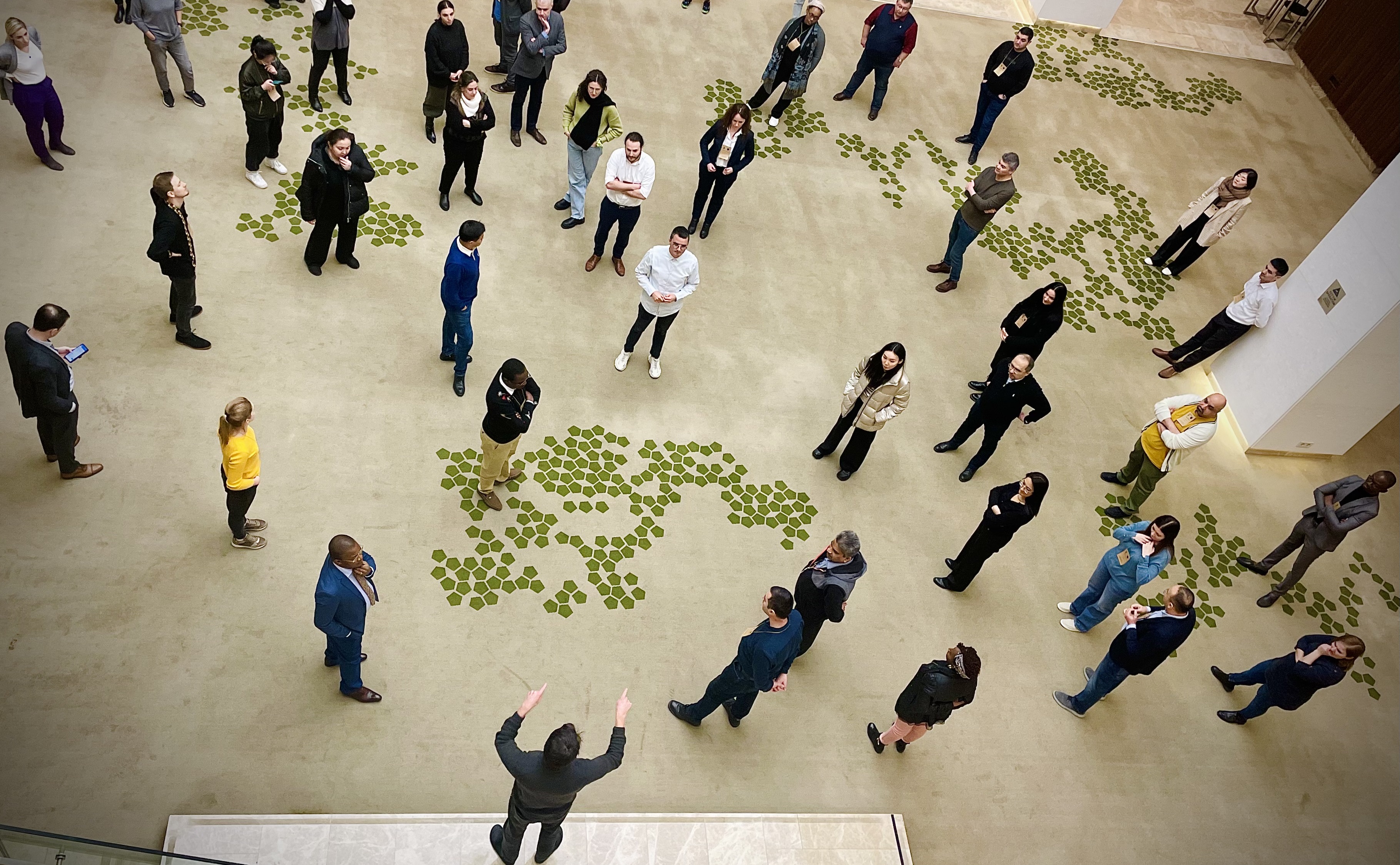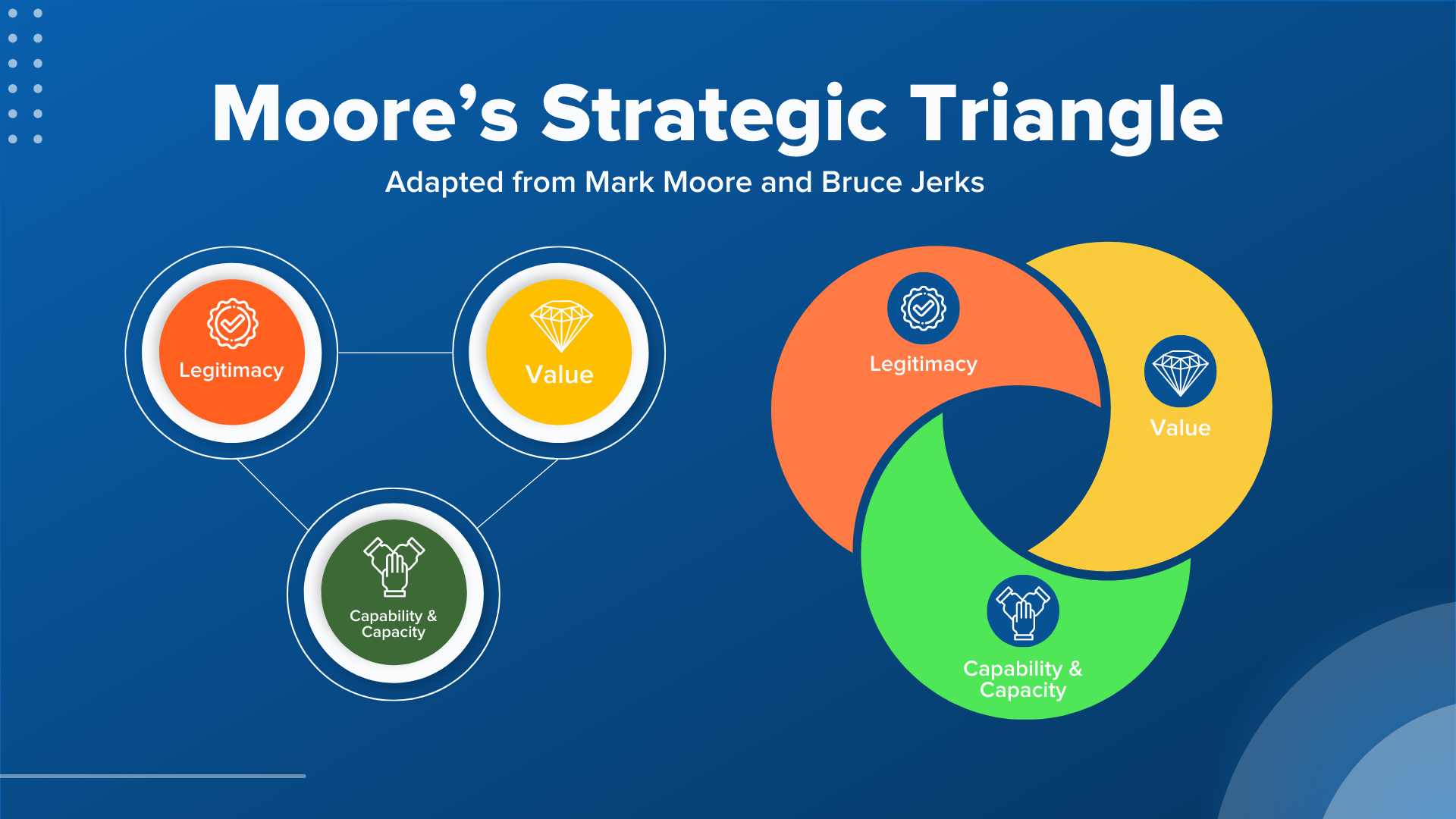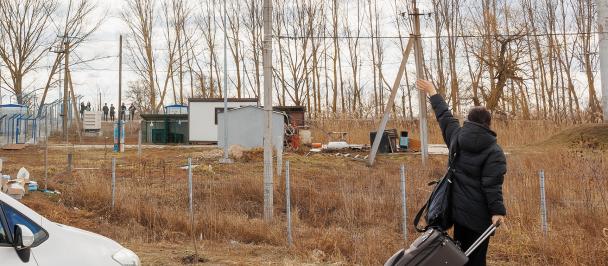‘Circling’ out of UNDP’s business model dilemma
Radical collaboration
March 21, 2023

The scale of uncertainty and complexity of today’s development challenges requires a different level of ambition and courage to tackle shared challenges.
In my previous blog post, “the primacy of relevance and trust – ‘circling’ into UNDP’s business model dilemma,” I used Mark Moore’s strategic triangle to illustrate the growing credibility and relevance gap UNDP may be facing if the ambitious leap in its value proposition - to achieve systemic, transformative change (UNDP Strategic Plan 2022-2025) - is not supported by a commensurate leap in its authorizing environment (legitimacy) and its capacity to deliver, i.e., in its overall business model. Diminishing core resources and the competitive, projectized funding environment that sustains much of the organization instead run counter to the alignment of the three variables or “circles,” which Moore places at the heart of public sector strategy: an organization’s value, legitimacy, and capacity.

This post seeks to address some of the “so what?” questions that followed through a lens of “radical collaboration.” It argues that the scale of uncertainty and complexity of today’s development challenges needs a different level of ambition and courage in tackling shared complex challenges and a different quality of collaboration, way beyond projects and conventional organizational and vertical boundaries. No organization, government or any other single entity for that matter can navigate the complexity and uncertainty we are facing today on its own. Radical uncertainty requires radical collaboration (Seppälä/Dunlop, 2021).
Investments in aligning UNDP’s capacity and authorizing environment with its value proposition (Strategic Plan) would need to be bold, synchronized (to keep the “three circles” converging) and go beyond UNDP itself to effect real change. Short-term, inward-looking fixes and lack of ambition play into long-term marginalization. Legitimacy and relevance accrue to those who have the capacity and capability to integrate and to collaborate systemically, not to those who compete, compartmentalize and projectize.
Aligning capacities and capabilities
The COVID-19 pandemic underscored the need for a different quality and scale of collaboration in international development. As part of its ‘Lessons in Multilateral Effectiveness’ series, the MOPAN network explored the obstacles multilateral organizations faced in responding to the COVID-19 crisis needs of host countries during the first year of the pandemic as well as factors for a better coordinated emergency response (MOPAN, 2022). The study concludes among its 5 lessons for multilateral responses to future crises that “… important barriers limit the extent of joint planning and programming” and that “fragmentation in resource mobilization contributes to competition, works against joint programming and undermines the achievement of collective outcomes”. Since the first year of COVID-19, crises and uncertainties have multiplied.
Over the past years, UNDP has been investing strategically in its “capacity circle,” notably in the formation of a Global Policy Network; in a global network of Accelerator Labs; in strategic innovation and in the shift from project- to portfolio-approaches; in innovative approaches to finance, digital, data, knowledge and much more. Years back, it was UNDP that advocated for pooled, multi-stakeholder funding, ‘invented’ what has since become known as multi-partner trust funds and established the UN’s Multi-Partner Trust Fund Office. These investments provide UNDP with launch pads, not just to demonstrate its integrator role in the UN development system, but also for a much more collaborative and strategic business model, beyond the current “world of (UNDP-led) projects.” These investments position UNDP well to embrace more extrovert, collaborative partnership approaches, mobilizing external capacities and capabilities that are complementary to its own.
Cooperation and partnerships are deeply engrained in UNDP’s DNA, but in their current form they tend to iterate on the prevailing, competitive business model of project delivery and absorb time and resources, project by project. Radical collaboration would imply a rethink; outward-looking strategic choices and imagination to mobilize capacities and capabilities for systemic change at scale.
Imagine, in a cascading order …
… if organizations currently competing for the same funding complemented their capabilities strategically with a long-term, systemic orientation, based on mandates and comparative advantages relevant to the challenge … and if donors, in turn, combined their funding and pursued long-term joint investments in systemic portfolios, turning traditional requests for proposals (“RFPs”) into open collaboration and partnership opportunities
…if, in the same vein, the Funding Compact and the Humanitarian Grand Bargain increased targets for strategic, flexible UN financing from the original 15 per cent to, say, 50 per cent, moving it from the margins to mainstream
…if multilateral (like the World Bank, UNDP, and UNEP); bilateral (such as GIZ, SIDA or USAID); innovative, new organizations (e.g., EIT Climate-KIC); and the private sector companies built a climate/energy alliance - or if the EU, UNDP and EBRD funded an urban transformation portfolio - based not on the usual bilateral “memoranda of understanding,” but by complementing or even partly merging their capacities and capabilities, bringing to bear their comparative strengths and advantages
… if UN development system reform would build on an intergovernmental consensus strong enough to go beyond coordination and operational effectiveness (as important as they are in their own right) and make strategic choices, such as dismantling duplicative or redundant capacities and consolidating or building capacities where they are needed now. Imagine if, as a result, the system would be positioned to maximize synergies between its global analytical and normative work, regional perspectives, and country-level interventions. Joined up this way, the UN development system would be unique. In its current state, the UN’s many competitive and discordant niche players tend to court those who argue for a UN à la carte in which UN agencies, funds and programmes tend to be reduced to contractors (Jenks, Barcena, Doryan, Civili, 2010).
… if organizations like UNDP and the World Bank shared or even partly merged their capabilities based on the obvious complementarity of their horizontal mandates and created an unprecedented level of presence, reach, access, and financial strength. As far-fetched and unrealistic as such imaginings may sound today, open discussions in this direction happened before, e.g., under the leadership of UNDP’s late Associate Administrator George Arthur Brown in the 1980s, in a different time and context.
"Legitimacy and relevance accrue to those who have the capacity and capability to integrate and to collaborate systemically, not to those who compete, compartmentalize and projectize."
Aligning the authorizing environment
UNDP’s authorizing environment is complex and fragmented. Simplistically put, two parallel, but intersecting authorizing environments direct and influence the organization: the UN’s internal governance structures (UNDP’s Executive Board in the first instance), and the UN’s dispersed and projectized funding environment. Both are increasingly complicated; both are crumbling in face of the emerging geopolitical and socio-economic landscape.
The world today is facing a “Zeitenwende” (turning point in history) - to use the “word of the year 2022”. We need to re-assess the extent to which new forms of collaboration, inclusion and representation in the intergovernmental domain are politically feasible. Or, if they were considered not feasible so far, how they can be made feasible. It may be time to turn the old serenity prayer “[…] grant me the serenity to accept the things I cannot change, courage to change the things I can, and the wisdom to know the difference […]” back to its original. The prayer originally asked for courage first, and specifically for changing things that must be changed, not things that simply can be changed.
Any form of organizational, functional, or sectoral capacity alliances or even mergers would require not only the consent, but also active political support of the authorizing environment. UNDP would need to explore the extent to which member states which have strongly endorsed its Strategic Plan are ready to support a bold level of ambition in achieving it. Or, conversely, what alternatives they would propose. Member states, too, are struggling with the global poly-crisis, individually in its domestic manifestations, and collectively. Many have voiced concerns about the future of multilateral cooperation, particularly in the wake of the war in Ukraine. Everyone looks at the world today differently than just a few years ago.
The future relevance and legitimacy of the UN system – and, thus, of UNDP - will at least partly be determined by its ability to marry the traditional inter-governmental order with the inclusion and representation of today’s diversity of influential non-state actors. This has been a topic for years in different forms and fora. The “Zeitenwende” we face puts a different quality and significance and maybe also a different level of imagination to it.
Imagine, keeping in mind the corresponding ‘imagines’ above,…
… a ‘GAVI moment’ (Dunlop, 2021) for systemic, transformative change with UNDP’s governing structures providing space, voice and vote for parliaments, local governments and civil society side by side with inter-governmental representation. The GFATM, ILO’s tripartite tradition and UNICEF’s national committees might serve as variations of food for imagination.
… if donors, with confidence and trust deriving from such a boost in representation and building on a structured and substantive, IDA-like dialogue co-led by UNDP’s Global Policy Network, would collectively provide the core resources necessary for UNDP to achieve its Strategic Plan. Core resources are merely a reflection of relevance and trust.
… if the organizational and thematic strategies, frameworks and offers which every organization, including UNDP and its board members, tend to produce individually, were aligned or even co-created from the outset rather than developed separately as individual positioning tools at extra cost.
…if such an inclusive and representative governing structure applied to the kind of organizational or functional mergers described above, e.g., between UNDP and the World Bank. Given its broad, horizontal mandate, UNDP never really had a distinct (vertical) ministerial constituency across all member states. Long perceived as a disadvantage, this positioning may turn into a strategic advantage if UNDP overcomes its own structural silos and demonstrates its integrator role in the UN development system. A functional merger with an equally broad-based international financial institution like the World Bank would create a distinct constituency for both organizations: heads of state and government … at a time, when member states themselves are increasingly challenged to rethink and integrate their own departmentalized structures and need to be able to tap into the best available global expertise.
If the value UNDP seeks to create was business as usual, its authorizing environment and capacities could just tag along; a scenario which would seem like ‘circling the wagons’ and waiting for the storms of crises and uncertainties to pass. On the contrary, UNDP’s Strategic Plan reflects courageous ambition, foresight, and leadership. UNDP seeks to achieve systemic, transformative change. Now its authorizing environment and its capacity need to catch up and align. The art of aligning value, legitimacy and capacity is the art of public sector strategy. Mark Moore’s circles become a virtuous cycle when they converge; a vicious cycle when they drift apart.
Gerd Trogemann with thanks and appreciation to Jennifer Topping, Giulio Quaggiotto and Mourad Wahba for ideas, advice, and review

 Locations
Locations
